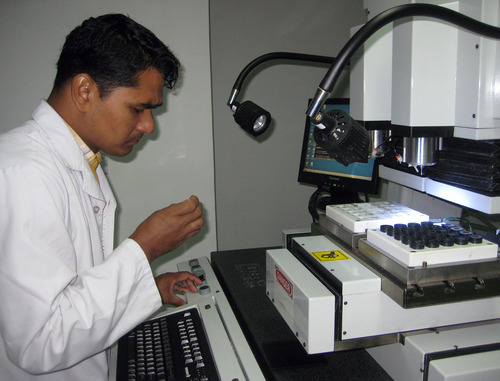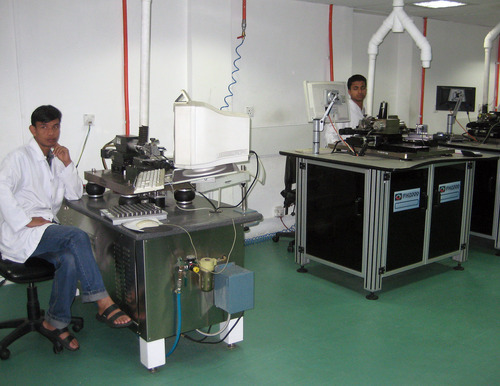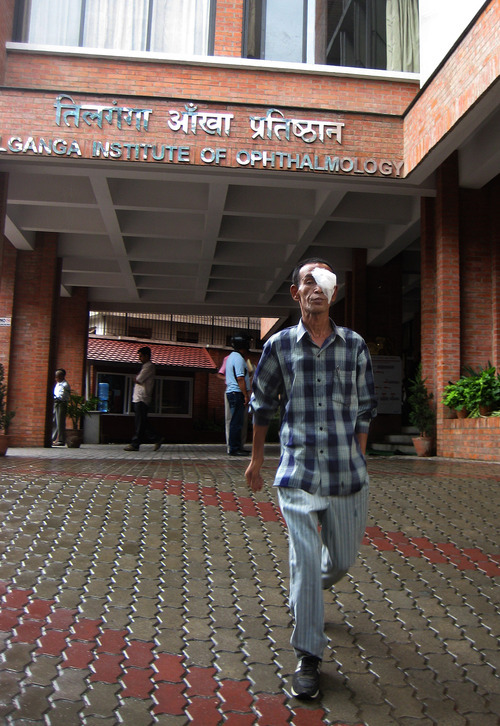This is an archived article that was published on sltrib.com in 2012, and information in the article may be outdated. It is provided only for personal research purposes and may not be reprinted.
Kathmandu, Nepal • Overjoyed, they often weep, their tears falling from eyes that are no longer blind.
Patient after patient, sometimes hundreds in one day, they flow into Tilganga Eye Centre in Kathmandu, their sight clouded by cataract and other types of treatable blindness. They leave seeing the world again, relieved of a tremendous burden Nepal's deeply impoverished and caste-based society places on the vision-impaired.
The eye clinic, in the Guashala area of Nepal's capital city, has restored sight to hundreds of thousands of blind residents and brought high-quality, inexpensive eye surgeries to one of Asia's poorest regions — with pivotal work from a top physician at the John A. Moran Eye Center in Salt Lake City.
"I never lose my excitement for that moment, especially people who have no idea they are going to regain their sight," said Moran ophthalmologist Geoffrey Tabin, a witness to the event thousands of times.
"There's disbelief and recognition and emotion," he said. "It makes me so excited to be a doctor, every time."
Many people set out to improve life for those in crushing poverty in the developing world. Few succeed on a scale as wide and dramatic as Tabin and others led by renowned Nepali eye surgeon Sanduk Ruit, Tilganga's director.
"He's one of the greatest creative geniuses in world medicine today," Tabin said of Ruit, who also is a co-founder of the Himalayan Cataract Project, a charity now fighting blindness on a global scale.
As hallways buzzed with hospital business outside, Ruit, 57, sat in a modest office at Tilganga and recalled the shock of reading an early 1980s study that showed, among other things, that 80 percent of blindness in Nepal was either preventable or treatable. Ruit and his friend and teacher Fred Hollows, a New Zealand-born ophthalmologist, began to dream.
"Very wild dreams," Ruit said with a smile. "We had a dream of providing modern cataract surgery in a set-up like ours."
They eventually would take a small medical team into rural Nepal — "the bush," Ruit called it. They tested and developed a variety of experimental surgical techniques using small eye incisions to implant intraocular lenses, a technology considered new at the time, all while relying on low-end tools and only basic medical facilities.
When they emerged five years later "with some answers, but still confused," said Ruit, the field results they presented met with ardent objections from medical officials in Nepal, India, the World Health Organization and U.S.-based National Institutes of Health. Concerns focused on standards of care and infection risk.
"There was a lot of opposition, virtually outlawed," Ruit said. "We had to walk out of the meeting."
Today, Tilganga is considered a world-class surgical facility, training institute and ground-breaking clearinghouse for cornea transplants. Ruit and Tabin both credit a team of top-notch professions involved. "There is a shared vision," said Ruit.
Another major factor in its success is Tilganga's ability to deliver care that is affordable in Nepal, where residents live on an average of $1 per day. It receives funding from the U.S. Agency for International Development, but also spreads costs based on ability to pay. Patients range from beggars to members of Nepal's former royal family.
Tilganga's volume is high, having grown from 980 procedures in 1994 to nearly seven times that today, with doctors sometimes performing hundreds in a day. Operating rooms have honed high-efficiency methods for moving support personnel and sterilizing instruments, bought at a fraction of prices in the West.
A full tray of surgical tools in Nepal costs $175, said Tabin. "At Moran, I don't even have a single pair of tweezers that costs less than $175."
The clinic's manufacturing plant makes hard intraocular lenses for less than $3.50 apiece, compared to nearly $100 per lens in America. It produces about 30,000 lenses monthly, with each 18-millimeter diameter circle of glass machined to exacting international standards. Lens are exported to Pakistan, China, Turkey and elsewhere to subsidize patient care.
"We feel proud to work here," said Kali Prasad Baskod, senior production technician.
Tilganga has established Nepal's first eye bank for cornea transplants, a practice facing steep cultural obstacles. Nepal's predominant faiths of Hinduism and Buddhism include beliefs in reincarnation, the idea that souls come back in future lives. Potential donor families often refuse because they fear their deceased loved ones won't have eyes in their next life or won't be able to see heaven.
"It's superstition, but mostly people don't know that," said Bhola K.C., technologist at Tilganga's Eye Bank, who noted such fears are not supported by actual Hindu or Buddhist doctrine. "The religious community is very helpful."
Tilganga now has 12 clinical facilities across Nepal, with two more in the works, and has pushed its medical presence to neighboring Bhutan, Pakistan, northern India and beyond. "We have done it all over Asia and all over Africa now," said Ruit, a 2006 winner of the Ramon Magsaysay Award for International Understanding, dubbed Asia's Nobel Prize.
Tabin entered the picture around 1994, an avid mountain climber drawn to Nepal by its Himalayan peaks. After a 15-day visit to Nepal as a young surgeon, he returned again and, at Ruit's urging, helped train surgeons in eastern Nepal. Tabin then returned a third time.
"Geoff always kept pushing and asking to do more," said Ruit, with another wry smile. "I found his energy extraordinary."
Said Tabin: "I was really fortuitous to be at the right place at the right time."
Tabin has since taken an instrumental role internationally in helping Tilganga expand, by raising money, working through the Himalayan Cataract Project and fostering physician-exchange visits between Tilganga and Moran. The Utah-based doctor recently returned from Ethiopia, where a surgical team using the Tilganga model performed 1,137 sight-restoring surgeries in a week.
The goal now, said Tabin, is to have strong programs in Ethiopia, Ghana and Rwanda within five years. "We're getting a lot done," he said. "But there is a lot still to do."
About this series
P Saturday • Utahns trek to their faith's homeland
Sunday • USU climate study key to Nepal's future
Monday • Utahn helps Nepali clinic fight blindness

















